Evaluation of Multidisciplinary Collaborative Care in Patients with Acute Coronary Syndrome and Depression and/or Anxiety Disorders
Feng Liang, Xiuhua Ma, Liuzhuang Zhao, Chengwei Xing, Xin Li, Dongjing Zhao,Da-Yi Hu, Shuoqiang Hu, Wenbin Wang, Lantang Han, Shujun Cao, Huifang Liu and Zhengyu Bian
1Department of Cardiology, Daxing Hospital, Capital University of Medical Science, Beijing 102600, China
2Cardiac Center, Beijing People’s Hospital, Beijing University, Beijing 100044, China
3Daxing Community Service Center, Daxing District, Beijing 102600, China
4Department of Psychiatry, Daxing Psychiatric Hospital, Beijing 102600, China
Introduction
Patients with an acute coronary syndrome (ACS) and symptoms of depression and anxiety not only experience higher rates of long-term morbidity and death but also report a worse health-related quality of life than patients without symptoms of these psychiatric disorders. Identification of the symptom pro files of these psychiatric disorders will help to design tailored interventions aimed at improving quality of life and other clinical outcomes in these high-risk patients[1–3]. In the present study, the effects of multidisciplinary collaborative care (MCC) compared with usual physician care (UPC) were evaluated in ACS patients with depression and/or anxiety disorders.
Patients and Methods
Eligibility Criteria
The inclusion criteria were as follows:patients admitted to the coronary care unit or cardiac inpatient units for ACS; age older than 18 years; signed informed consent form.
The exclusion criteria were as follows: linguistic difficulties such as those resulting from advanced age and aphasia caused by cerebrovascular disease; psychosis or dementia; paralysis; patients with severe systemic disease who could not perform daily activities;severe, life-threatening cardiac and noncardiac disease implying that the patient could not participate in the 3-year study; New York Heart Association (NYHA)functional class IV; current alcohol or substance abuse;inability to comply with the trial protocol.
Ethics and Informed Consent
The study was approved by the Daxing Hospital Committee on Biomedical Research Ethics. Written consent was obtained from each patient. All patients were recruited from the cardiology ward during hospitalization from October 2011 to June 2012 at Daxing Hospital, Capital University of Medical Science.
Cardiac Assessment
Cardiac evaluation was performed at the baseline,and included risk factors for cardiovascular disease,history of myocardial infarction (MI), stent implantation, bypass surgery, and cerebrovascular disease,and medications. The Canadian Cardiovascular Society grade for angina and the NYHA functional class were estimated, and heart rate and arterial blood pressure were measured.
A standard 12-lead ECG and transthoracic echocardiographic examination were performed during the hospital stay. In biochemical analysis, hemoglobin level, cardiac troponin T level, D-dimer level, and high-sensitivity C-reactive protein level were examined. CT coronary angiography, invasive coronary arteriography, or both were performed in most patients.
Screening and Assessment of Depression and Anxiety, and Randomization
The Self-Rating Depression Scale (SDS) and the Self-Rating Anxiety Scale (SAS) screening questionnaires concerning depression and anxiety were administered to the patients with ACS.The scoring was conducted on the basis of the 20 items in the SDS and SAS questionnaires (see Appendices 1 and 2). The standard score was calculated by multiplication of the total score by 1.25. Depression severity was stratified into mild depression for a standard score of 53–62, moderate depression for a standard score of 63–72, and severe depression for a standard score of more than 72. Anxiety severity was stratified into mild anxiety for a standard score of 50–59, moderate anxiety for a standard score of 60–69, and severe anxiety for a standard score of more than 69. By the screening, depression and anxiety disorders were identified among the patients with ACS, and the ACS patients without depression and/or anxiety served as the control group.
ACS patients with depression and/or anxiety disorders were consecutively randomized to the MCC group and the UPC group.
Multidisciplinary Collaborative Care
Multidisciplinary teams were established with members from the fields of cardiology, psychiatry,and primary care practice (community physicians participated). Patients in the MCC group received MCC. The MCC strategy was established by the members of the multidisciplinary team, including cardiologists, psychiatrists, and general practitioners, and is described briefly next.
Patients in MCC group received standard therapy(a combination of lifestyle modification, guidelinedirected medical therapy, percutaneous coronary intervention, and coronary artery bypass graft[CABG] surgery) during the hospital stay in accordance with clinical practice guidelines [4–6]. Every patient in the MCC group was seen and followed up by a psychiatrist.
In patients in the MCC group, psychoanalytical therapy and cognitive behavioral therapy were administered, including individual or group counseling on psychosocial risk factors and coping with the illness, integrating health education, stress management programs, cognitive restructuring, and problem-solving techniques. As antidepressant/anxiolytic medication, flupentixol-melitracen, fluoxetine, or paroxetine was generally recommended.Lorazepam and traditional Chinese medicine might be used in combination in selected patients.
Optimal medical therapy (guideline-directed medical therapy) was recommended for secondary prevention. The goals of risk factor management were as follows: healthy eating habits (DASH diet recommended); smoking cessation; regular physical activity (at least 30 min five times a week); blood pressure less than 130/80 mmHg; low-density lipoprotein cholesterol level less than 2.1 mmol/L (80 mg/dL);among patients with type 2 diabetes, fasting blood glucose level of 7.0 mmol/L (125 mg/dL) or less and hemoglobin A1cfraction of 7.0% or less for age 65 years or older, and fasting blood glucose level of 6.1 mmol/L (125 mg/dL) or less and hemoglobin A1cfraction of 6.5% or less for age less than 65 years;avoidance of excessive stress [7, 8].
The health education programs for cardiovascular disease prevention, relief of depression, and relief of anxiety was held regularly for the patients in the MCC group. Written materials on cardiovascular rehabilitation, secondary prevention, and the antianxiety and antidepression strategy were also given to the patients in the MCC group at the baseline and regularly.
The specific care was given by the multidisciplinary team, especially the general practitioners. During the course of the care after discharge,the general practitioners in every township health center were responsible for the deployment of collaborative care for the patients in the MCC group in the region, and checked and promoted the implementation of every measure for the patients every month by visiting their home or seeing them in the consulting room according to the MCC strategies.MCC was not administered to the patients in the UPC and control groups, for whom only instructions for outpatient visits were provided and outpatient visits were made regularly at the discretion of the patients.
Evaluation of Effect and Adherence for Risk Factor Management, Psychological Interventions, and Health Education at the 6-Month Follow-Up
The effect and adherence for risk factor management, psychological interventions, and health education were followed up at 6 months after enrollment. The items were as follows: achievement of the goal for blood pressure, fasting blood glucose level, and low-density lipoprotein cholesterol level,smoking cessation, healthy eating habits, control of alcohol intake, regular physical activity, watching and participation in a health promotion training program, return to work, medication for depression and anxiety, and referral to another hospital within 6 months.
Cardiovascular and Behavioral Outcomes at the 1-Year Follow-Up
The cardiovascular end points were cardiac death,nonfatal MI, composite events of cardiac death and nonfatal MI, the rate of NYHA functional class III or IV, the incidence of angina pectoris events, the incidence of cerebrovascular events,renal insufficiency (serum creatinine level greater than 133 µmol/L), the incidence of unplanned revascularization (e.g., percutaneous coronary intervention or CABG), and the incidence of readmission.
The behavioral measures were the incidence of poor appetite, the incidence of dyssomnia (night sleep time less than 5 h), and the rate of return to work.
Data Analysis and Statistical Methods
The three groups at the baseline and at the 6-month follow-up were compared with use oft-tests for continuous variables and χ2tests for categorical variables. Our main outcomes for this trial were the differences in improvements in cardiac outcomes between the MCC group and the UPC group at 1 year after enrollment. The cumulative event rates were analyzed with χ2tests for determination of statistical significance. Data were analyzed according to the per-protocol (efficacy population) principle with IBM SPSS Statistics version 19.
All statistical tests were two-group comparisons among the three patient groups. For the end-point analysis between the MCC group and the UPC group at the 1-year follow up, the 95% confidence interval of the estimated effect was derived. All tests of statistical significance were interpreted with a criterion ofP<0.05.
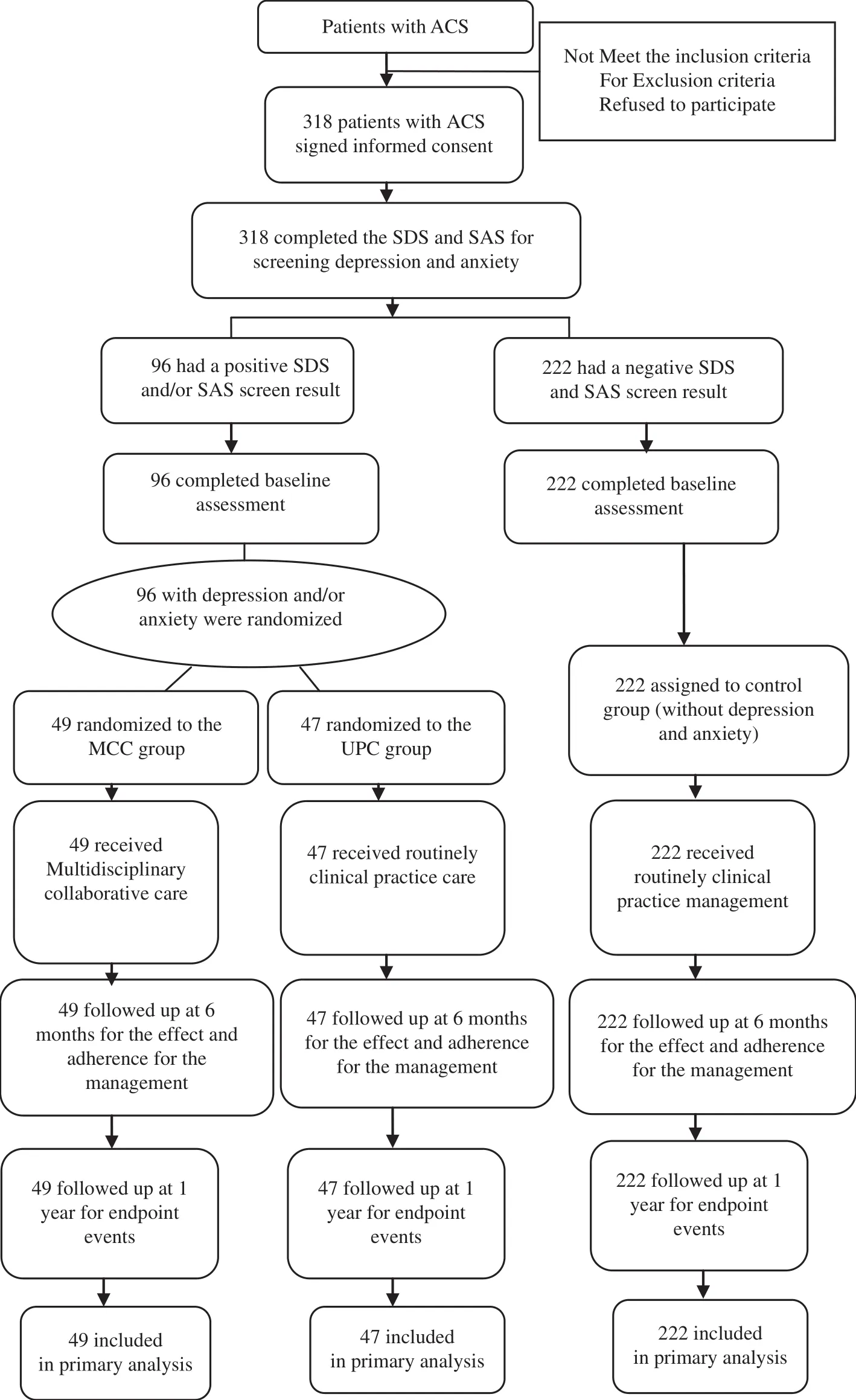
Figure 1 Flowchart of Participants.
Results
Screening of Depression and Anxiety,and Randomization
Overall, 318 patients were enrolled, and of the 318 ACS patients consenting to participate in the study,30.19% (96/318) had positive screening results during their hospital stay (49 randomly assigned to the MCC group, and 47 randomly assigned to the UPC group). Figure 1 displays the flowchart for the patients throughout the study.

Baseline Characteristics
The control, MCC, and UPC groups were generally comparable with respect to all baseline demographic and clinical characteristics (Table 1).However, compared with the patients in the UPC group, patients in the MCC group tended to be slightly younger (62.27±8.31 years vs. 66.70±7.39 years,P=0.007). After enrollment, MCC was administered to the patients in the MCC group, so the percentage of patients taking antidepressant/anxiolytic medication was significantly greater in the MCC group than in the UPC group (55.10% vs,12.77%,P<0.0005). In addition, there were more patients taking antidepressant/anxiolytic medication in the UPC group than in the control group at the hospital (P=0.008).
Assessment of the Proportion and Severity of Depression and/or Anxiety
Of the 96 patients with depression and/or anxiety,78.13% (75/96) were depressed, 63.54% (61/96)had anxiety, 41.67% (40/96) met both screening criteria, 29.33% (22/75) had moderate to severe depression, and 26.23% (16/61) had moderate to severe anxiety. There were no significant differences in the proportion and severity of depression and/or anxiety between the patients in the MCC group and the patients in the UPC group (Table 2).
Evaluation of Effect and Adherence for Risk Factor Management, Psychological Interventions, and Health Education at the 6-Month Follow-up
At 6 months after ACS, depression, anxiety, or both were associated with increased risk of cardiovascular disease, and most of the risk factors worsened more significantly in the UPC group than in the control group: the rate of blood pressure control (P<0.0005), fasting blood glucose level (P<0.0005), low-density lipoprotein cholesterol level (P<0.0005), alcohol intake (P=0.002),rate of participation in regular physical activity(P<0.0005), rate of participation in a health promotion training program (P<0.0005), rate of return to work (P=0.001), and percentages taking medication for depression and anxiety (P<0.0005) weresignificantly lower in the UPC group than in the control group.

Table 2 The Proportion and Severity of Depression and/or Anxiety in the Patients with Acute Coronary Syndrome Randomized to the Multidisciplinary Collaborative Care Group and the Usual Physician Care Group.
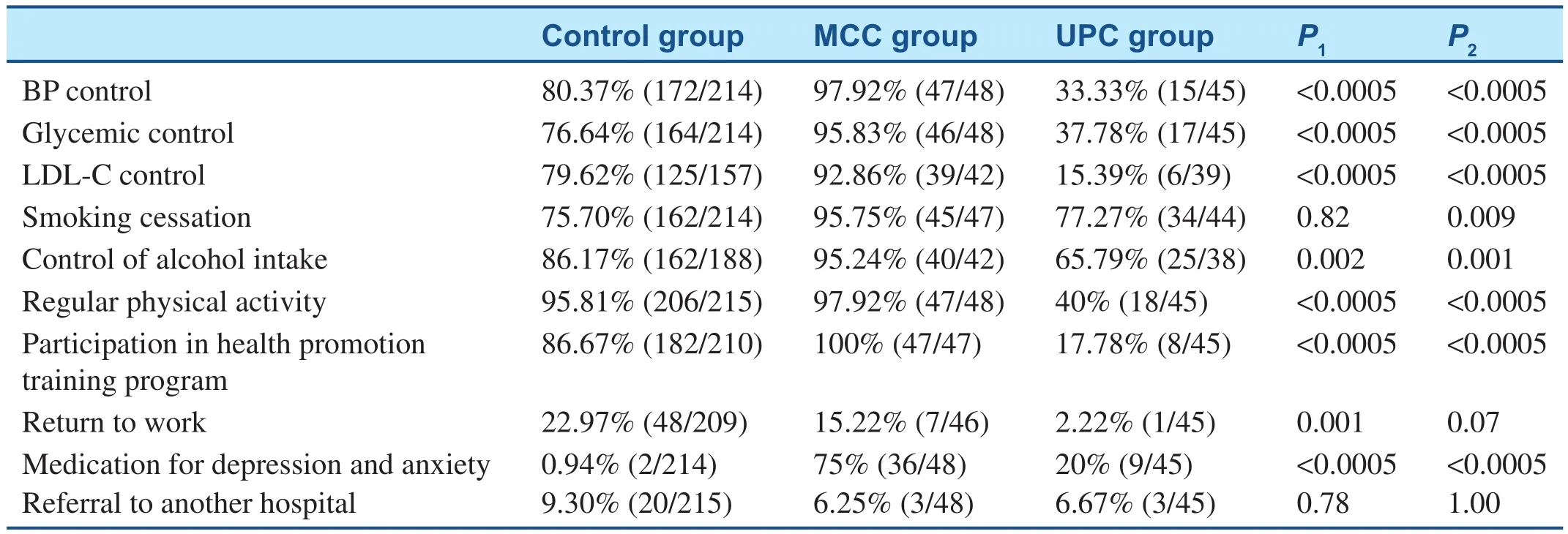
Table 3 Evaluation of Effect and Adherence for Risk Factor Management, Psychological Interventions, and Health Education at the 6-Month Follow-Up.
After enrollment, MCC was administered to the patients in the MCC group; and at the 6-month follow-up, most of the risk factors had lessened more significantly in the MCC group than in the UPC group (as Table 3). There were significant differences in the rate of blood pressure control, fasting blood glucose level, low-density lipoprotein cholesterol level, rate of participation in regular physical activity and a health promotion training program,and the percentages taking medication for depression and anxiety between the MCC group and the UPC group (P<0.0005 for all). The rate of smoking cessation was significantly higher in the MCC group than in the UPC group at the 6-month follow-up (P=0.009). The rate of control of alcohol intake was significantly different between the MCC group and the UPC group at the 6-month followup (P=0.001). The percentages of patients returning to work and referred to another hospital were almost identical between the MCC group and the UPC group at the 6-month follow-up (P=0.07 andP=1.00 respectively) (Table 3).
Cardiovascular and Behavioral Outcomes at the 1-Year Follow-up
At the 1-year follow-up, cardiac death (P=0.03),composite events of cardiac death and nonfatal MI (P=0.002), and episodes of angina (P<0.0005)occurred more significantly in the UPC group than in the control group. More patients in the UPC group than in the control group had poor appetite and dyssomnia, and the readmission rate and the rate of return to work were lower in the UPC group than in the control group (P<0.0005 for all).
At the 1-year follow-up after MCC, cardiac outcome measures for the MCC group were significantly better for composite events of cardiac death and nonfatal MI (6.12% vs. 23.40%,P=0.016), cardiac function (NYHA functional class III or IV; 0% vs.25%,P=0.05), and angina pectoris events (21.28%vs. 85%,P<0.0005) than for the UPC group. The rates of cardiac death (4.08% vs. 12.77%,P=0.24)and nonfatal MI (2.13% vs. 12.20%,P=0.15) were somewhat lower in the MCC group than in the UPC group, but the differences were not significant. The incidence of cerebrovascular events, renal insufficiency, revascularization, arrhythmia events, and readmission was similar between the MCC group and the UPC group (Table 4). Significant improvements in behavioral measures were achieved in the MCC group compared with the UPC group with regard to appetite (poor appetite, 6.38% vs. 65.85%,P<0.0005), sleep (dyssomnia, 14.89% vs 58.54%,P<0.0005), and return to work (21.95% vs. 2.44%,P=0.007) (Table 4).
Discussion
After ACS, major depression has a prevalence of more than 10%, and less severe symptoms of depression are found in 20–30% of patients after ACS, with similar prevalence rates for anxiety[9, 10]. Despite the high prevalence of depression and anxiety, the conditions remain underdiagnosed and undertreated in ACS patients.
Most studies that have examined the relationship between increased depression severity and cardiac events have shown a dose-response relationship,with severer depression associated with earlier and severer cardiac events [11, 12]. A longitudinal study of post-ACS depression found that baseline depression severity a few weeks after ACS was a strong and independent risk factor for cardiac death 7 years after the index event. This and other studies indicated that ACS patients whose depression is resistant to standard treatments appear to be at the highest risk of experiencing adverse cardiac outcomes [13].
Anxiety often persists after such cardiac events,and many patients have clinically significant anxiety up to 2 years later among those with anxiety shortly after ACS [14]. Several studies have found that elevated anxiety after MI has been independently associated with in-hospital cardiac complications, as well as longer-term cardiac complications and death [15, 16].
Many patients with coronary artery disease continue to face challenges maintaining adherence to recommendations for risk reduction, especially ACS patients with depression and anxiety disorders.Depression or anxiety negatively affects medical management of the disease and self-care behaviors,and leads to poorer quality of life and high costs for risk modification. Together, these continued challenges place individuals with these diseases at an increased risk of further cardiac illness and death.There is general consensus that depression remains associated with at least a doubling in the risk of cardiac events in a period of 1–2 years after an MI [17].
In this study we found that after ACS, 30.19%of the patients had depression and/or anxiety disorders: the proportions of patients with depression and anxiety among ACS were 23.59% (75/318)and 19.18% (61/318) respectively, and 41.97%(40/96) of depressed patients with ACS had concomitant anxiety. At 6 months after ACS events,hypertension, diabetes, dyslipidemia, and alcohol intake were poorly controlled, with less participation in regular physical activity and a health promotion training program, and the rate of return to work was less in ACS patients with depression and/or anxiety disorders. ACS patients with symptoms of depression and/or anxiety were associated with more cardiac events (cardiac death, composite events of cardiac death and nonfatal MI), more episodes of angina, and also more patients being readmitted to the hospital, poor appetite and dyssomnia, and a lower rate of return to work at the 1-year follow-up.
Currently, it is very important to find a simple and applicable screening technique to help frontline clinicians identify depression and anxiety among their patients with cardiovascular disease.Furthermore, it is necessary that identified patients receive basic, but critical, treatments for these disorders. The collaborative care models should be developed and further investigated in clinical
practice and research. The care manager should coordinate treatment between the patient, primary care physician, cardiologist, and consulting psychiatrist in a longitudinal manner. Such models have been found to significantly improve depression and anxiety outcomes in outpatient and post-CABG medical settings [18]. Patients with ACS may be the population to benefit most from the care management programs because of the strong association between depression/anxiety and medical outcomes. However, such a care management program has not been initiated in the hospital for patients with ACS, despite the consistent links between depression and negative short-term and long-term outcomes in unstable angina and acute MI patients [19].
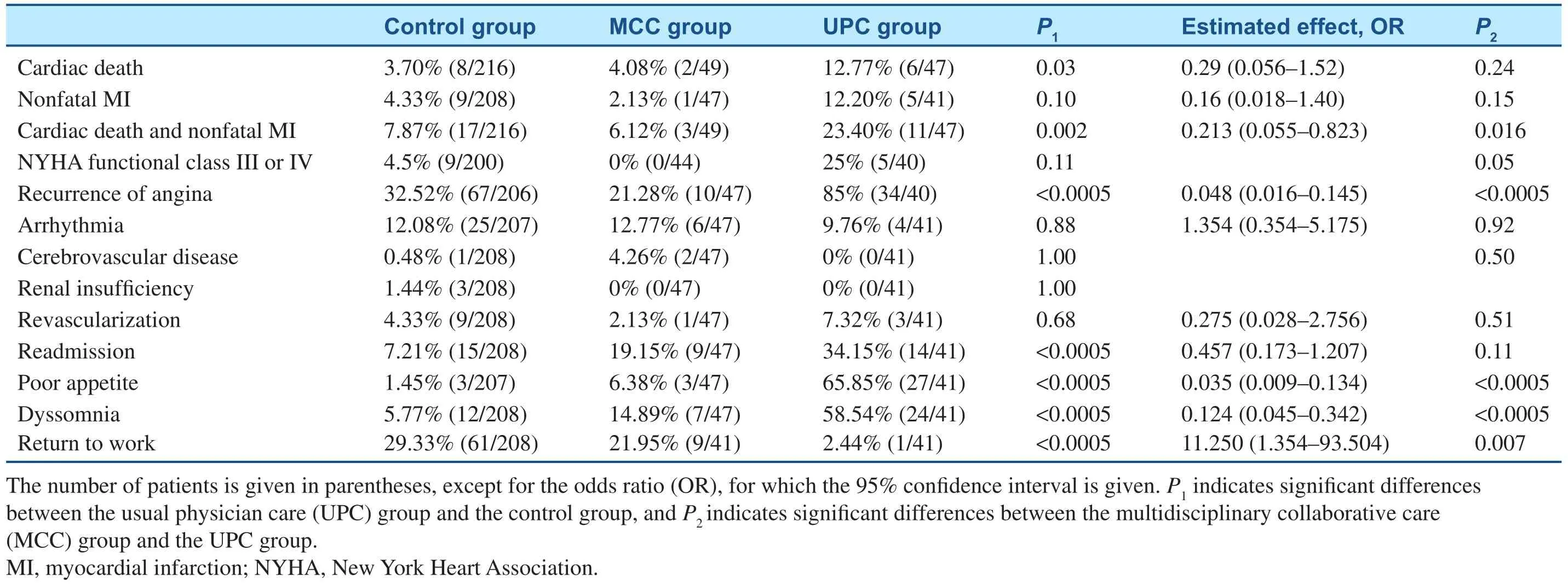
Table 4Cardiovascular Outcomes at the 1-Year Follow-Up.
In the present study, a multidisciplinary team was established with members from the fields of cardiology, psychiatry, and general practice (community physicians participated), and MCC was administered to ACS patients with depression and/or anxiety disorders. The prevalence of risk factors for cardiovascular disease was significantly reduced at the 6-month follow-up. Furthermore, at the 1-year follow-up, MCC significantly improved cardiac outcomes, with a lower rate of composite events of cardiac death and nonfatal MI, fewer angina attacks, and improvement of heart function.Mental and social functioning improvements were achieved after MCC, such as improvements with regard to appetite, sleep, and rate of return to work.However, more studies are needed to con firm the preliminary results.
The ENRICHD and SAD-HART trials [20, 21]did not show cardiac outcome improvement through treatment of depression and increase of social support after ACS, which is why were the results of this study are different from those of the ENRICHD and SAD-HART trials. We interpreted the difference as follows. First, the trial design and intervention strategies were fundamentally different. The ENRICHD trial aimed to determine whether mortality and recurrent infarction are reduced by treatment of depression and low perceived social support (LPSS) with cognitive behavioral therapy, and the SAD-HART trial aimed to evaluate the safety and efficacy of sertraline treatment of major depressive disorder;in this study, the effects of MCC were evaluated in ACS patients with depression and/or anxiety disorders, and the cardiac outcome improvement was achieved through MCC. Second, in the ENRICHD trial, less severe depression and LPSS were diagnosed in most patients: 39% were depressed, 26% had LPSS, and 34% met both criteria, and the patients with the diagnoses may be the population who benefit least from treatment.In this study, 23.59% had depression and 19.18%had anxiety, and severe depression and anxiety were diagnosed, corresponding to the population who may benefit most. Third, in the ENRICHD trial, supplemental analyses showed that antidepressant drug use was associated with a lower risk of the primary outcome, with a crude hazard ratio for death or nonfatal MI of 0.67 (95% confidence interval 0.49–0.92) and an adjusted hazard ratio of 0.63 (95% confidence interval 0.46–0.87), and the rates of any antidepressant use in the usual care and intervention arms, respectively, were 4.8% and 9.1% at the baseline, 13.4% and 20.5%at the 6-month follow-up, and 20.6% and 28% by the end of follow-up; but in this study, the rates of antidepressant/anxiolytic medication use in the UPC group and the MCC group were, respectively,12.77% and 55.10% (P<0.0005) after enrollment and 20% and 75% (P<0.0005) at the 6-month follow-up. Fourth, intervention group patients with scores higher than 24 on the Hamilton Rating Scale for Depression or those who showed a less than 50% reduction in the Beck Depression Inventory scores after 5 weeks were referred to study psychiatrists for consideration of pharmacotherapy in the ENRICHD trial; however, in our trial every patient in the MCC group was seen and followed up by a psychiatrist.
There are some limitations in this study, the first and most obvious limitation being that a selfreported measurement of depression and anxiety was used. It is possible that this mirrored the relationship between perceived depression and anxiety (not objective) and ACS. Even so, it is still an important finding. Secondly, this is a single-center trial and there were a small number of patients in the study; almost all patients were recruited from the Beijing region. In addition, previous studies have found that depression and anxiety dominated by somatic symptoms may have worse outcomes than depression dominated by cognitive symptoms [22].In the present study, somatic and cognitive subtypes of depression and anxiety were not differentiated,so more trials are needed to further investigate the association of cognitive and somatic symptoms of depression and anxiety with long-term quality of life and cardiac outcomes in patients with ACS.
Conclusion
After ACS, 30.19% of patients had depression and/or anxiety disorders, which led to poorer modification of risk factors for coronary heart disease, and these disorders were associated with poorer cardiac outcomes and reduced quality of life. MCC had better effects on cardiac outcomes and quality of life in ACS patients with depression and/or anxiety disorders.
Acknowledgments
This work was supported by a grant from the Beijing Municipal Health Bureau for high-level health professionals (grant no. 2009-3-68), and the Capital Development Foundation of Medical Scientific Research (grant no. 2009-3261).
Conflict of Interest
The authors declare that they have no conflict of interest.
Appendix 1: Self-Rating Depression Scale
Please read each statement and decide how much of the time the statement describes how you have been feeling during the past several days.
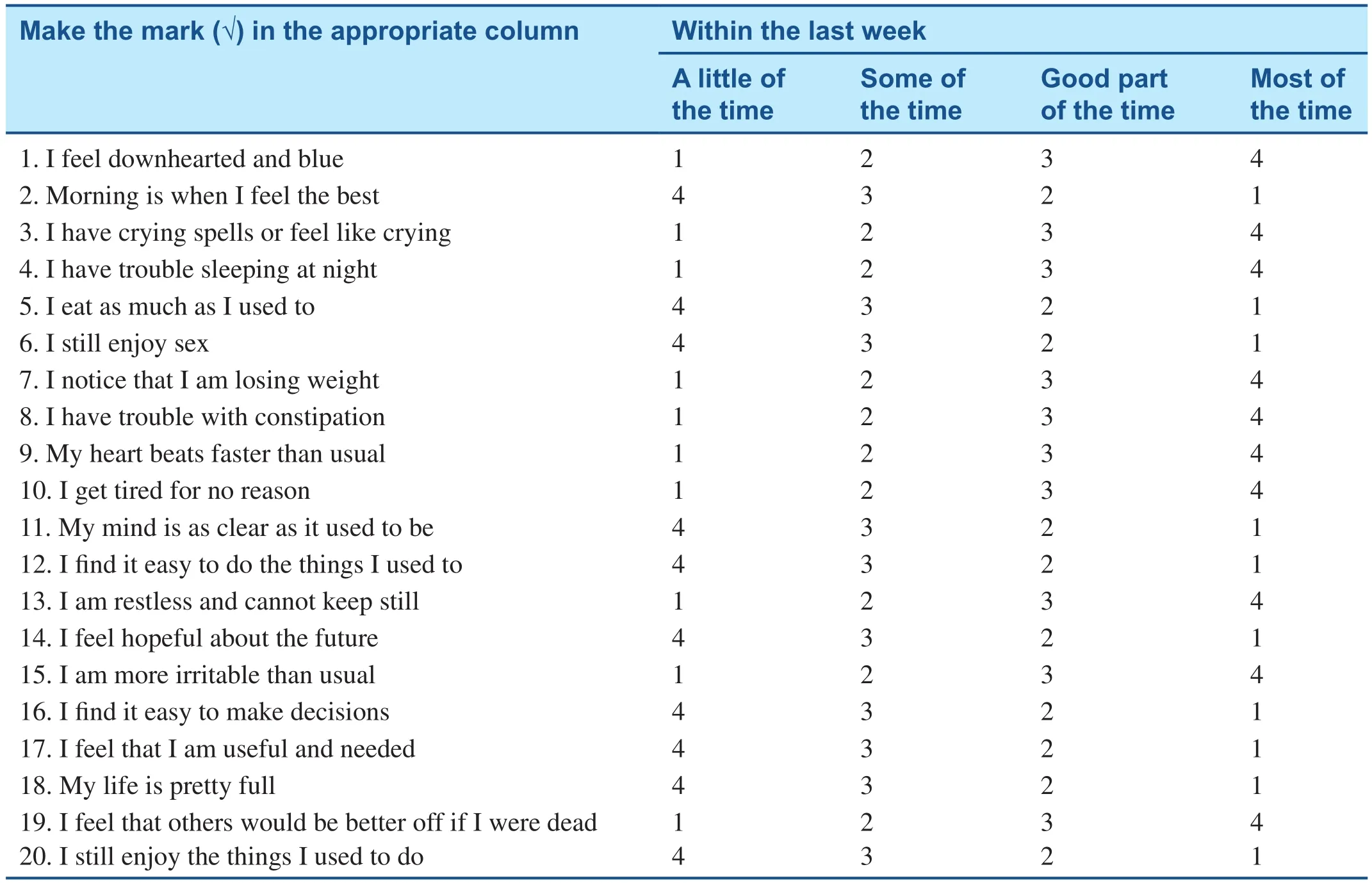
Consult this key for the value 1–4 that correlates with the patient’s response to each statement. Add up the numbers for the total score. The standard score is calculated by multiplication of the total score by 1.25.
Appendix 2: Self-Rating Anxiety Scale
Listed below are 20 statements. Please read each one carefully and decide how much the statement describes how you have been feelingduring the past week. Circle the appropriate number for each statement.
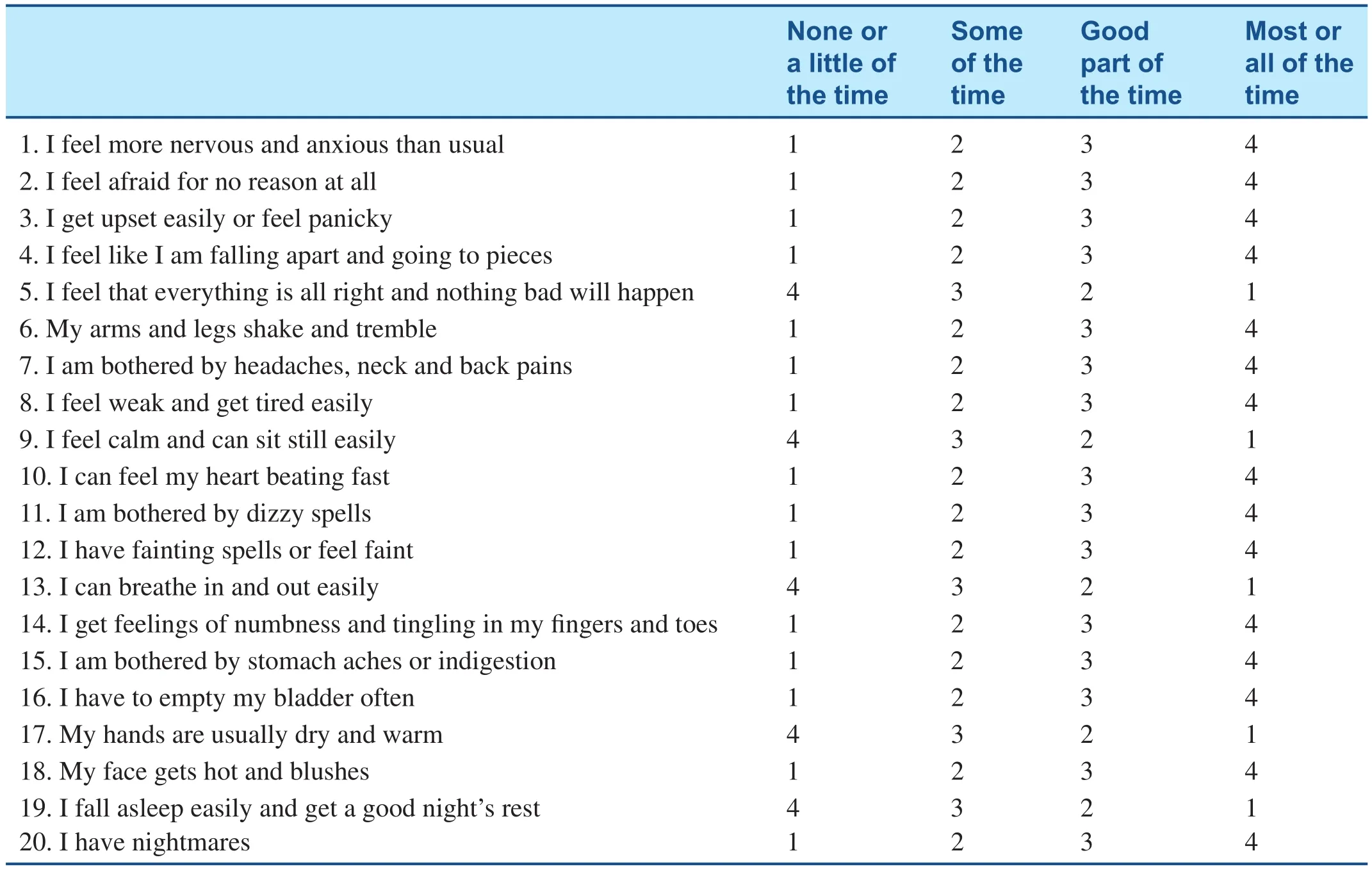
Patients will circle one of the four numbers in response to the questions. The health care provider, nurse, or medical staff assistant then scores the completed questionnaire. Check that all statements have been answered. Add up the values for each response to get the total score. The standard score is calculated by multiplication of the total score by 1.25.
REFERENCES
1. Lichtman JH, Bigger JT Jr,Blumenthal JA, Frasure-Smith N,Kaufmann PG, Lespérance F, et al.Depression and coronary heart disease: recommendations for screening, referral, and treatment. A science advisory from the American Heart Association Prevention Committee of the Council on Cardiovascular Nursing, Council on Clinical Cardiology, Council on Epidemiology and Prevention, and Interdisciplinary Council on Quality of Care and Outcomes Research.Circulation 2008;118:1768–75.
2. Tisminetzky M, Bray BC, Miozzo R, Aupont O, McLaughlin TJ.Identifying symptom pro files of depression and anxiety in patients with an acute coronary syndrome using latent class and latent transition analysis. Int J Psychiatry Med 2011;42:195–210.
3. Roy-Byrne P, Craske MG, Sullivan G, Rose RD, Edlund MJ, Lang AJ,et al. Delivery of evidence-based treatment for multiple anxiety disorders in primary care: a randomized controlled trial. JAMA 2010;303:1921–8.
4. China Society of Cardiology of Chinese Medical Association,Editorial Board of Chinese Journal of Cardiology. Guideline for the diagnosis and treatment of acute ST segment elevation myocardial infarction. Zhonghua Xin Xue Guan Bing Za Zhi 2010;38:675–90.
5. China Society of Cardiology of Chinese Medical Association,Editorial Board of Chinese Journal of Cardiology. Guideline for diagnosis and treatment of patients with unstable angina and non-ST-segment elevation myocardial infarction. Zhonghua Xin Xue Guan Bing Za Zhi 2007;35:295–304.
6. Hillis LD, Smith PK, Anderson JL,Bittl JA, Bridges CR, Byrne JG,et al. 2011 ACCF/AHA guideline for coronary artery bypass graft surgery: executive summary: a report of the American College of Cardiology Foundation/American Heart Association Task Force on Practice Guidelines. Circulation 2011;124:2610–42.
7. China Society of Cardiology of Chinese Medical Association,Editorial Board of Chinese Journal of Cardiology. Guideline for diagnosis and treatment of patients with chronic stable angina (no abstract).Zhonghua Xin Xue Guan Bing Za Zhi 2007;35:195–206.
8. Hall SL, Lorenc T. Secondary prevention of coronary artery disease. Am Fam Physician 2010;81:289–96.
9. Jiang W, Velazquez EJ,Kuchibhatla M, Samad Z, Boyle SH, Kuhn C, et al. Effect of escitalopram on mental stressinduced myocardial ischemia:results of the REMIT trial. JAMA 2013;309:2139–49.
10. Colquhoun DM, Bunker SJ, Clarke DM, Glozier N, Hare DL, Hickie IB, et al: Screening, referral and treatment for depression in patients with coronary heart disease. Med J Aust 2013;198:483–4.
11. Rugulies R. Depression as a predictor for coronary heart disease:a review and meta-analysis. Am J Prev Med 2002;23:51–61.
12. Frasure-Smith N, Lespérance F.Reflections on depression as a cardiac risk factor. Psychosom Med 2005;67:S19–25.
13. Carney RM, Freedland KE.Treatment-resistant depression and mortality after acute coronary syndrome. Am J Psychiatry 2009;166:410–7.
14. Pedersen SS, Smith OR, De Vries J, Appels A, Denollet J. Course of anxiety symptoms over an 18-month period in exhausted patients post percutaneous coronary intervention.Psychosom Med 2008;70:349–55.
15. Huffman JC, Smith FA, Blais MA, Januzzi JL, Fricchione GL.Anxiety, independent of depressive symptoms, is associated with in-hospital cardiac complications after acute myocardial infarction. J Psychosom Res 2008;65:557–63.
16. Grace SL, Abbey SE, Irvine J, Shnek ZM, Stewart DE.Prospective examination of anxiety persistence and its relationship to cardiac symptoms and recurrent cardiac events. Psychother Psychosom 2004;73:344–52.
17. van Melle JP, de Jonge P, Spijkerman TA, Tijssen JG, Ormel J, van Veldhuisen DJ, et al. Prognostic association of depression following myocardial infarction with mortality and cardiovascular events:a meta-analysis. Psychosom Med 2004;66:814–22.
18. Rollman BL, Belnap BH,LeMenager MS, Mazumdar S,Houck PR, Counihan PJ, et al.Telephone delivered collaborative care for treating post-CABG depression: a randomized controlled trial.JAMA 2009;302:2095–103.
19. Huffman JC, Mastromauro CA,Sowden G, Fricchione GL, Healy BC, Januzzi JL. Impact of a depression care management program for hospitalized cardiac patients.Circ Cardiovasc Qual Outcomes 2011;4:198–205.
20. Berkman LF, Blumenthal J,Burg M, Carney RM, Catellier D, Cowan MJ, et al. Effects of treating depression and low perceived social support on clinical events after myocardial infarction: the Enhancing Recovery in Coronary Heart Disease Patients(ENRICHD) randomized trial.JAMA 2003;289:3106–16.
21. Glassman AH, O’Connor CM, Califf RM, Swedberg K,Schwartz P, Bigger JT Jr, et al.Sertraline treatment of major depression in patients with acute MI or unstable angina. JAMA 2002;288:701–9.
22. Nabi H, Hall M, Koskenvuo M,Singh-Manoux A, Oksanen T,Suominen S, et al. Psychological and somatic symptoms of anxiety and risk of coronary heart disease: the health and social support prospective cohort study. Biol Psychiatry 2010;67:378–85.
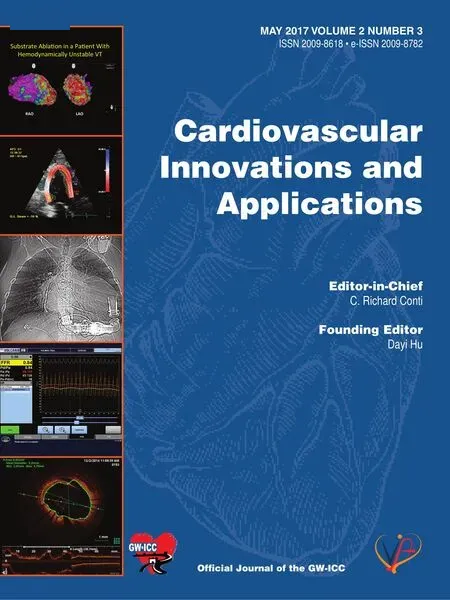 Cardiovascular Innovations and Applications2017年2期
Cardiovascular Innovations and Applications2017年2期
- Cardiovascular Innovations and Applications的其它文章
- Relationship Between Morning Hypertension and T-Peak to T-End Interval in Patients with Suspected Coronary Heart Disease
- Occlusive Spasm of the Left Anterior Descending Artery and First Diagonal Branch After Implantation of Everolimus Eluting Stents Without Re-stenosis in a Female Patient with Resting Angina
- Chronic Kidney Disease is a New Target of Cardiac Rehabilitation
- Role of Cholesterol Crystals During Acute Myocardial Infarction and Cerebrovascular Accident
- Digoxin and Heart Failure: Are We Clear Yet?
- Telemedicine: Its Importance in Cardiology Practice. Experience in Chile
